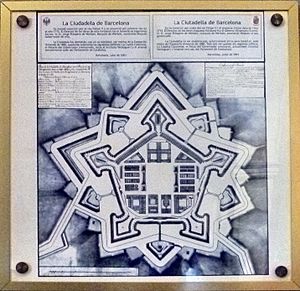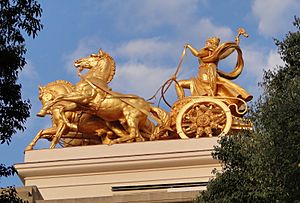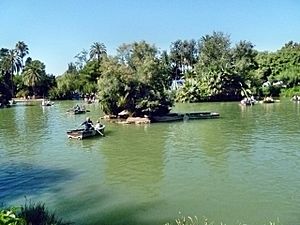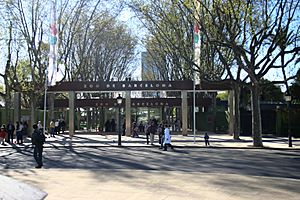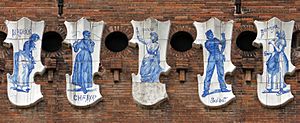Parc de la Ciutadella facts for kids
Quick facts for kids Parc de la Ciutadella |
|
|---|---|
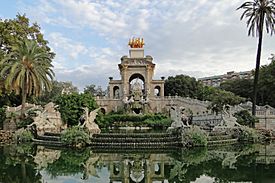
The park's fountain
|
|
| Type | Historical garden |
| Location | Barcelona |
| Area | 31 hectares (77 acres) |
| Created | 1877 |
| Status | Open all year |
| Website | Parcs i jardins de Barcelona |
| Type | Non-movable |
| Criteria | Historic Garden |
| Designated | 21 December 1951 |
| Reference no. | RI-52-0000030 |
The Parc de la Ciutadella (which means "Citadel Park" in Catalan) is a beautiful park in Barcelona, Spain. For many years, it was the only large green space in the city. The park is huge, covering about 31 hectares (that's like 76 football fields!). Inside, you'll find the famous Barcelona Zoo, a lovely lake, museums, and a big, fancy fountain. This fountain was designed by Josep Fontserè, with some help from a young Antoni Gaudí.
The park is also home to the Palau del Parlament de Catalunya, which is where the government of Catalonia meets. Sometimes, the park might be closed to the public for security reasons when important meetings are happening there.
Contents
Discovering Ciutadella Park
The Old Citadel's Story
In 1714, Barcelona was under attack during the War of the Spanish Succession. After a long siege, the city was taken by the army of Philip V of Spain. To keep control, Philip V built a huge fortress called the Citadel. It was one of the biggest fortresses in Europe at the time.
Building the Citadel meant destroying a large part of a neighborhood called La Ribera. Many people lost their homes. The fortress had five strong corners for defense. It also had a wide open space around it for cannons. Inside, there were enough buildings for 8,000 soldiers.
Hundreds of Catalans were forced to build it for three years. The city also had to pay for it with a new tax. About 30 years later, a new area called Barceloneta was built near the fortress.
Over time, the people of Barcelona really disliked the Citadel. They saw it as a symbol of being controlled. In 1841, the city decided to tear it down. But then, it was rebuilt in 1843. Later, in 1848, a general named Espartero destroyed most of the buildings and walls by bombing it from Montjuic mountain.
Finally, in 1869, the remaining parts of the fortress were given to the city. More buildings were torn down. The old chapel, the Governor's palace, and the arsenal (now the Catalan Parliament building) were saved. The rest of the area was turned into the park we see today by architect Josep Fontsére in 1872.
In 1888, Barcelona hosted a big event called the Universal Exhibition. The park was redesigned with new sculptures and art for this event. This helped Barcelona become a modern, exciting city. Later, part of the park was changed again to make space for the zoo.
There's also a bandstand in the park called Glorieta de la Transsexual Sònia. It's dedicated to a transsexual woman named Sonia Rescalvo Zafra.
The Grand Cascada Fountain
The Cascada (which means "waterfall" in Spanish) is a magnificent fountain in the northern part of the park. It was first opened in 1881. At first, it was quite plain, so people didn't like it much. It was then improved with more details and sculptures, taking six years to finish (from 1882 to 1888).
The Cascada was a big attraction at the Universal Exhibition. It was designed by Josep Fontserè, with some help from a young Antoni Gaudí. Fontserè wanted it to look a bit like the famous Trevi Fountain in Rome.
You can climb up some stairs that look like giant crab claws to a small platform. In front of the fountain, there's a sculpture of Venus standing on an open clam shell. The whole waterfall is split into two levels. From the platform, you can walk to another sculpture or go down the stairs to walk around the fountain's pond.
Barcelona Zoo: Home to Amazing Animals
The Barcelona Zoo is located right inside Ciutadella Park. It found its home here because some buildings were left empty after the Universal Exhibition in 1888. The zoo officially opened in 1892. The first animals were given to the city by a man named Lluís Martí i Codolar.
Today, the Barcelona Zoo has one of the largest collections of animals in Europe. Its main goals are to protect animals, study them, and teach people about them.
From 1966 to 2003, the zoo was famous for Snowflake, a rare albino gorilla. He brought many visitors from all over the world.
The zoo offers more than just visits. You can join guided tours or take part in workshops. There are special trips for schoolchildren and courses for adults who want to learn about zoology. More than 50,000 children visit the zoo every year, which is why education is so important there.
Museum of Natural Sciences of Barcelona
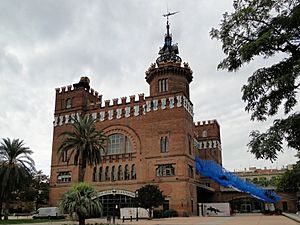
The Museum of Natural Sciences of Barcelona has two parts located in the park: a zoology museum and a geology museum. These museums were managed by the city for many years. They are currently closed as the Museum of Natural Sciences plans new ways to use them.
The building known as the Castle of the Three Dragons was built for the 1888 Universal Exhibition. It was designed by architect Lluís Doménech i Montaner. Most of the building is made of red brick. In 1920, it became the museum of zoology. When it was open, popular displays included a whale skeleton and exhibits for children. It also had valuable collections of animals, birds, and even a bee farm. The museum aimed to teach people about nature and how to respect it.
The geology museum used to have exhibits on mineralogy (the study of minerals), petrology (the study of rocks), and paleontology (the study of fossils). It also featured the volcanic area of Olot and the hidden colors of minerals. Its collections came from a scientist named Francisco Martorell i Peña. He gave his entire collection of cultural and scientific items, his library, and money to the city to create a new museum. The building was designed by Antoni Rivas i Trias.
Als Voluntaris Catalans Monument
This monument is a sculpture dedicated to Catalan volunteers. It was created by Josep Clarà. The project faced delays due to political changes. It was finally placed in Ciutadella Park, where it stands today.
Getting to the Park
The park is easy to reach by public transport. The Barcelona Metro station Ciutadella-Vila Olímpica (on line L4) is named after the park. However, the park entrance is closer to the metro and train station Arc de Triomf. The city's main bus station, Estació del Nord, is also nearby.
See also
 In Spanish: Parque de la Ciudadela para niños
In Spanish: Parque de la Ciudadela para niños
- Urban planning of Barcelona


